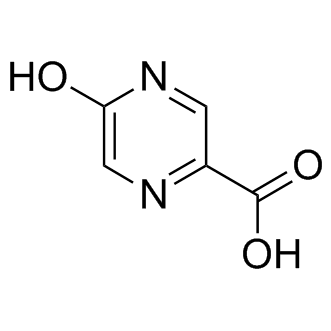| Reference | <p style=/line-height:25px/>
<br>[1]. Huq, Fazlul; Hossain, Zahed. Molecular modelling analysis of the metabolism of pyrazinamide. Journal of Pharmacology and Toxicology (2006), 1(6), 505-515.
Abstract
Tuberculosis is a global health problem of escalating proportions esp. due to the prevalence of the acquired immunodeficiency syndrome (AIDS) that has greatly increased the incidence of the disease over the first few years. A commonly used front-line anti-tuberculosis drug is pyrazinamide (PZA) that causes dose-dependent hepatotoxicity, manifested by hepatocellular dysfunction. The exact of mechanism of action of PZA and that of its toxicity remain unclear. In vivo, PZA is metabolized in the liver to form the main metabolite pyrazinoic acid (PA) by enzymic deamination. PA is oxidized by the action of xanthine oxidase (XO) to form 5-OH-PA which is the main excretory metabolite of PZA. PZA is also directly oxidized to form 5-OH-PZA by XO. A small amt. of PU is produced by conjugation of PA with glycine. Mol. modeling analyses show that PZA and its metabolites may be subject to electrophilic attack at a no. of sites including the two pyrazine ring nitrogens. Neither PZA nor any of its metabolites have very small HOMO-LUMO energy differences so that none is expected to be highly labile kinetically and none can be excluded from being the cause for the toxicity of PZA.
<br>[2]. Mehmedagic, Aida; Verite, Philippe; Menager, Sabine et al. Investigation of the effects of concomitant caffeine administration on the metabolic disposition of pyrazinamide in rats. Biopharmaceutics & Drug Disposition (2002), 23(5), 191-195.
Abstract
The utility of pyrazinamide (PZA) in the short-course antituberculous treatment is well established. All available data support the idea that the PZA metabolite pyrazinoic acid (PA) is the active compd. against M. tuberculosis. This situation warranted a deeper investigation of possible interactions with respect to its metabolic disposition. Caffeine, which is widely used as a drug and is a common constituent of most diets, shares with PZA the same metabolic enzyme, xanthine oxidase (XO). This study investigated if, and in what manner, concomitant administration of caffeine affects PZA metab. PZA and caffeine, in various doses (PZA = 50 or 100 mg kg-1 and caffeine = 0, 50, 100, and 150 mg kg-1), were administered to female Sprague-Dawley rats. PZA and its three main metabolites were quantified in 24 h urine samples by reversed phase-HPLC. Concomitant administration of 100 mg kg-1 caffeine and 50 mg kg-1 PZA increased from the excretion (p<0.05) of the most water-sol. and the least toxic PZA metabolite 5-hydroxypyrazinoic acid (5-OH-PA) from 66.18±10.87 to 94.56±8.65 μmol/24 h. This effect was more pronounced when 100 mg kg-1 of PZA was administered increasing excretion of 5-OH-PA from 113.28±70 to 173.23±17.82 μmol/24 h. These results show that the metabolic disposition of PZA is affected by concomitant caffeine intake.
</p>
|

